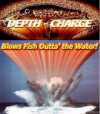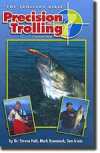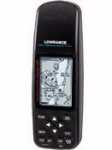
Click
here to see the new Depth charge Crankbaits

Precision Trolling Book 7th edition now on sale
at Walleyes Inc Click
here for more info

 












Promotional
Team Favorites
Lodging food and more






|
Icing Some Walleyes
By John Campbell
The key to ice fishing as it is in any fishing is location. For
walleye and other gamefish, try long tapering points; inside channel turns;
rock humps, neck downs, and structure near spring spawning areas.
Use the sonar to spot fish. Try submerged brush piles and blowdowns for
crappie and bluegill. Watch the screen or flasher. You can
actually see fish appear on a graph. Sensitive depthfinders track
your lure so you can put it right in the fish’s face. I have actually
seen a day when a mark appeared on the sonar screen while reeling in a
lure. A pause, and the mark moved closer to the bait. A twitch
of the wrist brought a powerful strike. A heart-racing fight put
a nice eight pound walleye on the ice. The same situation can be
used for panfish.
The "mood" of the fish (aggressive, neutral, negative) is a major consideration
in successful ice fishing. Good ice fisherman will find a way to trigger
neutral fish into biting. The best of them can trigger some negative fish
into biting.
Jigging walleyes is the most deadly method of all, if done properly.
Proper size, color selection and action all come into play. Early
season fishing I like to use a Jigging Rapala in chartreuse or silver and
black and this past year I really liked using the rainbow trout color.
I also spend a little extra time and put on the next size bigger treble
hook. This additional size hook allows me to put the head of a fathead
minnow on and still have plenty of play in the hook to jig a natural action
and increase hookups with additional space between the shank and the barb
of the hook.
It is a good idea to keep your jigging action down
to a minimum. But, you also have to respond to the mood of the fish.
If I find that the fish prefer to have a tempting morsel just quivered
in front of their face then I will do that. Other times the fish
might be attracted to the jig slamming into the sand and making a "plume
action" that stirs up the floor of the lake. When the Genz Worm is on the
bottom, impart a tapping movement to your rod. This causes the lure to
"stir up" the bottom. Then raise the Genz Worm slightly. This works best
on mud flats where the rising mud plume imitates natural baits, attracts
fish, and triggers strikes. The constant jigging or jiggling will keep
the lure from spinning. If allowed to merely hang, line twist will impart
an unnatural spin to the lure. This is usually a method when you
are fishing transitional areas where sand meets rock or mud.
Jigging action combined with sound of rattles has also been a new innovative
method that has really worked well.

 |
For this I will put on a Rattling Hooker from Lindy Tackle. This
added sound and vibration many times attracts fish when they are turned
off with other bait presentations. Always remember these walleyes
want an easy meal.
Light conditions and weather are two over looked aspects of early
ice fishing. Weather and time of day affect walleye activity in winter
much the same way they do at other times of the year. As you probably
already know, in the summer time most walleyes feed during low light
conditions. The light gathering qualities of the walleyes eyes are
far superior to that of the baitfish they prey upon. Naturally the
walleyes use this as an advantage and feed during the dim light periods.
Likewise, during overcast days they tend to bite more than during high
skies and bright sunshine |
Weather is just as much a factor as it is in the summer time.
When a storm is hitting the surface of the frozen lake the fish will turn
off and usually will go through a "cold front" condition after the storm
stops. The walleye likes to feed during stable weather and if you
are planning that early ice-time walleye trip check the weather before
and during your stay. Sometimes the approach of a winter storm will
trigger a feeding frenzy because of the advancement of low light conditions.
Fish small lakes at the beginning of the ice fishing
season and move to larger lakes later in the ice fishing season. This is
governed by oxygen in the water. In addition, smaller lakes freeze
sooner thus extending your ice fishing season. By far the best winter
angling on Mille Lacs, Lake of the Woods, Rainy, Leech and countless other
Minnesota lakes occurs from first ice through mid to late January. Fall
is a great time to "pre-fish" for ice fishing spots. Use your electronics
to locate concentrations of suspended fish they'll usually be there later-under
the ice.
 |
On larger bodies of water use your GPS to mark these spots. A GPS is
useful for marking spots that you might not return to for some time. As
ice fishing guru Dave Genz has said many times. Ice fishermen have to continue
"thinking fish" during the winter season. Don't put your "fishing knowledge"
away with your boat in the fall. Most summer fishermen have progressed
beyond their grandparent's ways of fishing, however, many of them revert
back to their grandparent's ways of ice fishing when they get on the ice |
On larger bodies of water use your GPS to mark these spots. A GPS is useful
for marking spots that you might not return to for some time.
As ice fishing guru Dave Genz has said many times. Ice fishermen have
to continue "thinking fish" during the winter season. Don't put your "fishing
knowledge" away with your boat in the fall. Most summer fishermen
have progressed beyond their grandparent's ways of fishing, however, many
of them revert back to their grandparent's ways of ice fishing when they
get on the ice.
Following these suggestions and jigging more next
time you hit that frozen lake will help with success in icing some walleyes.
For more information contact me on the Internet at www.walleye.info.
Hope to see you on some ice real soon
|




